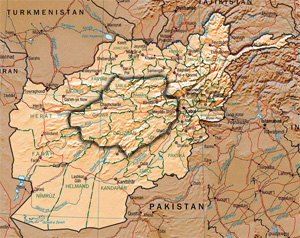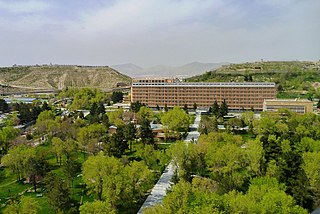
The politics of Afghanistan consists of the council of ministers, provincial governors and the national assembly, with a president serving as the head of state and commander-in-chief of the Afghan Armed Forces. The nation is currently led by President Ashraf Ghani who is backed by two vice presidents, Abdul Rashid Dostum and Sarwar Danish. In the last decade the politics of Afghanistan have been influenced by NATO countries, particularly the United States, in an effort to stabilise and democratise the country. In 2004, the nation's new constitution was adopted and an executive president was elected. The following year a general election to choose parliamentarians took place.

Hazāristān or Hazārajāt is a mountainous region in the central highlands of Afghanistan, among the Koh-i-Baba mountains in the western extremities of the Hindu Kush. It is the homeland of the Hazara people who make up the majority of its population. "Hazārajāt denotes an ethnic and religious zone rather than a geographical one—that of Afghanistan's Turko-Mongol Shiʿites." Hazarajat is primarily made up of the provinces of Bamyan, Daykundi, Ghor and large parts of Ghazni, Urozgan, Parwan and Wardak. The most populous towns in Hazarajat are Bamyan, Yakawlang (Bamyan), Nili (Daykundi), Lal wa Sarjangal (Ghor), Sang-e-Masha (Ghazni), Gizab (Urozgan) and Behsud (Wardak). The Kabul, Arghandab, Helmand, Farah, Hari, Murghab, Balkh and Kunduz rivers originate in Hazarajat.

A leper colony, leprosarium, or lazar house was historically a place to quarantine people with leprosy. The term lazaretto, which is derived from Saint Lazarus, can refer to quarantine sites, which were at some time also "colonies", or places where people affected by leprosy lived or were sent.

Mycobacterium leprae, also known as Hansen’s bacillus spirilly, mostly found in warm tropical countries, is a bacterium that causes leprosy. It is an intracellular, pleomorphic, acid-fast, pathogenic bacterium. M. leprae is an aerobic bacillus surrounded by the characteristic waxy coating unique to mycobacteria. In size and shape, it closely resembles Mycobacterium tuberculosis. Due to its thick waxy coating, M. leprae stains with a carbol fuchsin rather than with the traditional Gram stain. The culture takes several weeks to mature.
Lepra is a UK registered international charity (NGO). They work on projects in India, Bangladesh and Mozambique to treat, educate, rehabilitate and give a voice to people affected by disease, poverty, prejudice and discrimination.
Leprosy was said to be first recognized in the ancient civilizations of China, Egypt and India, according to the World Health Organization (WHO). Leprosy, also known as Hansen's disease, was officially eliminated at the national level in China by 1982, meaning prevalence is lower than 1 in 100,000. There are 3,510 active cases today. Though leprosy has been brought under control in general, the situation in some areas is worsening, according to China’s Ministry of Health. In the past, leprosy sufferers were ostracized by their communities as the disease was incurable, disfiguring and wrongly thought to be highly infectious.

Dr Ruth Katherina Martha Pfau HI, RM, HP, NQA, SQA was a German-born Pakistani physician and nun of the Society of the Daughters of the Heart of Mary. She moved from Germany to Pakistan and devoted more than 55 years of her life fighting leprosy in Pakistan.

Lal wa Sarjangal, is a district in the north-east of Ghor Province, Afghanistan. The district center is the town of Lal wa Sarjangal. The population of 250,000 is exclusively Hazara. However other sources suggest the population exceeds 250,000 individuals.

The Dr. Jose N. Rodriguez Memorial Hospital (DJNRMH), formerly known as Central Luzon Sanitarium, was established in 1940, to accommodate patients suffering from Hansen's Disease in the entire Luzon region in the Philippines. It is currently situated within the district of Tala, in Caloocan, Metro Manila, and occupies 130 hectares of land area, from the original 808 hectares. The reduction of land area was to accommodate previous homeless treated patients who eventually settled and established their own community, called Tala.
Yōhei Sasakawa is chairman of The Nippon Foundation, the World Health Organization Goodwill Ambassador for Leprosy Elimination, and Japan's Ambassador for the Human Rights of People Affected by leprosy. As chairman of The Nippon Foundation, Japan's largest charitable foundation, he is seen as a pioneer in guiding public-interest activities by the private in modern Japan. Sasakawa received his degree from Meiji University’s School of Political Science and Economics. Sasakawa's father was businessman, politician, and philanthropist Ryōichi Sasakawa.

Health in Afghanistan is unsatisfactory but slowly improving. The Ministry of Public Health oversees all matters concerning the health of Afghanistan's population. According to the Human Development Index, Afghanistan is the 15th least developed country in the world. Its average life expectancy at birth is reported at around 60 years. The country's maternal mortality rate is 396 deaths/100,000 live births and its infant mortality rate is 66 to 112.8 deaths in every 1,000 live births.
Dr. Hariharan Srinivasan was an Indian orthopedic surgeon who worked primarily with leprosy. He retired in 2008. He wrote under the pen name Charvakan in Tamil.
Marie Adelaide Leprosy Centre (MALC) in Karachi, Pakistan was run by Dr. Ruth Pfau, who was also a Roman Catholic religious sister of the Society of Daughters of the Heart of Mary, originally of German descent. Its social work department was founded 1962 by Dr. I. K. Gill and work for the leprosy patients and their family members was started. A Leprosy Clinic was bought in April 1963 and patients from all over Pakistan and even from Afghanistan came for treatment.
Leprosy stigma is a type of social stigma, a strong negative feeling towards a person with leprosy relating to their moral status in society. It is also referred to as leprosy-related stigma, leprostigma, and stigma of leprosy. Since ancient times leprosy instilled the practice of fear and avoidance in many societies because of the associated physical disfigurement and lack of understanding behind its cause. Because of the historical trauma the word "leprosy" invokes, the disease is now referred to as Hansen's disease, named after Gerhard Armauer Hansen who discovered Mycobacterium leprae, the bacterial agent that causes Hansen's disease. Those who have suffered from Hansen's disease describe the impact of social stigma as far worse than the physical manifestations despite it being only mildly contagious and pharmacologically curable. This sentiment is echoed by Weis and Ramakrishna, who noted that “the impact of the meaning of the disease may be a greater source of suffering than symptoms of the disease”.
The Leprosy Mission is an international Christian charity working towards the eradication of the causes and consequences of leprosy. It is active in over 50 countries around the world.
Leprosy currently affects approximately a quarter of a million people throughout the world, with majority of these cases being reported from India.
Vasant Ramji Khanolkar better known as V. R. Khanolkar was an Indian Pathologist.

MORHAN or Movement of Reintegration of Persons Afflicted by Hansen's disease in English, is a non-profit organization that operates to reduce leprosy and the stigma of leprosy in Brazil. This organization was initially created to ensure the rights of patients from leper colonies due to their isolation, and today it is one of the most successful Brazilian social movements, with representation in the National Health Council. The group has used several methods to disseminate information about leprosy including, but not limited to, handing out pamphlets, hosting seminars, and organizing puppet shows for children. Morhan also creates its own publications as a means of mobilization and news regarding leprosy. Furthermore, Morhan has worked with anthropologists to provide explanatory models and lay explanations of leprosy within the Brazilian context. Morhan's work has been exemplary in creating partnerships between social groups and the government and received an award from the United Nation’s Millennium Development Goals. The current National Coordinator is Artur Custodio Moreira de Souza.
Christian Fellowship in Richmond, a member of the Evangelical Alliance, is a church that meets at Halford House, a Grade II listed building in Halford Road, in the centre of Richmond, south-west London. In 1951 a group of young people gathered to pray in Richmond, which led to the founding of the church. The house was subsequently purchased in 1954.











